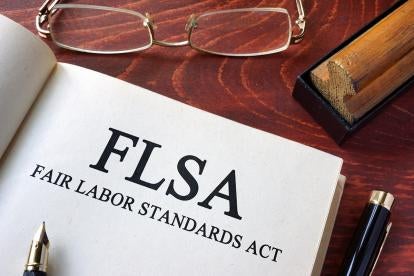On May 19, 2023, the United States Court of Appeals for the Sixth Circuit became the second circuit court to reject a familiar two-step certification procedure for collective actions under the Fair Labor Standards Act (FLSA). In Clark v. A&L Home Care and Training Center, LLC, the court held that FLSA plaintiffs who seek to represent other employees in a collective action must demonstrate a “strong likelihood” that other employees they seek to represent are “similarly situated” to the lead plaintiffs.
The Sixth Circuit’s “strong likelihood” standard deviates from the more lenient two-step standard that most other circuits apply, and also from the Fifth Circuit’s more onerous requirement that lead plaintiffs demonstrate that other employees are “actually similar” to them before a court can issue notice of a collective action.
Background Regarding FLSA Certification
The FLSA mandates that employers pay a federal minimum wage and overtime to certain types of employees. 29 U.S.C. §§ 206(a), 207(a). Employees can sue for alleged violations of those mandates on “behalf of . . . themselves and other employees similarly situated.” Id. § 216(b). But, “[n]o employee shall be a party plaintiff to any such action unless he gives his consent in writing to become such a party and such consent is filed in the court in which such action is brought.” Id. Thus, if they are “similarly situated,” other employees become parties to an FLSA suit only if they affirmatively choose to do so by opting in to the lawsuit.
Most district courts examine the viability of an FLSA collective action in two stages as first described in Lusardi v. Xerox, a District of New Jersey case from 1987. 118 F.R.D. 351, 361 (D.N.J. 1987). In the first step, a district court may facilitate notice of a FLSA suit to other employees upon a “modest factual showing” that they are “similarly situated” to the original plaintiffs. In the second stage, once merits discovery is complete, the court examines whether those other employees are, in fact, similarly situated to the original plaintiffs. To the extent the court concludes they are similarly situated, it then grants “final certification” for the case to proceed to decision as a collective action. In the decades since Lusardi, federal courts have often cited that case when applying the two-step certification procedure. Some federal courts, however, have begun to question this precedent.
The Fifth Circuit’s Decision in Swales v. KLLM Transp. Servs., L.L.C.
On January 12, 2021, a unanimous Fifth Circuit panel in Swales v. KLLM Transp. Servs., LLC rejected the Lusardi approach. 985 F.3d 430 (5th Cir. 2021). The court reasoned that the two-step procedure is flawed because (i) even courts applying the two-step certification procedure use different approaches based on the amount of discovery already completed; (ii) the text of the FLSA states nothing about conditional certification or a two-step procedure analysis; and (iii) courts cannot ensure that notice is distributed to similarly situated individuals if it distributes notice before the court reaches the merits issue of whether employees are actually similarly situated. Id. at 438-41.
The Fifth Circuit then articulated a new standard, explaining that district courts must instead: (i) identify at the outset of the litigation the facts and legal considerations material to determining whether a group of individuals is similarly situated for purposes of answering merits questions collectively; (ii) authorize the preliminary discovery necessary to make the similarly situated determination; and (iii) “rigorously scrutinize” the available evidence to determine whether and to whom notice should issue. Id. at 441-43.
The United States District Court for the Eastern District of Virginia (within the Fourth Circuit) in Mathews v. USA Today Sports Media Group, LLC recently adopted the Fifth Circuit’s approach. No. 1:22-CV-1407, 2023 WL 3676795, at *3 (E.D. Va. Apr. 14, 2023). According to the court in Mathews, the two-step process frequently results in notice being sent to potential plaintiffs who are not similarly situated and who can only be dismissed from the action in the second stage, which directly conflicts with the FLSA’s text, because that text authorizes notice only to similarly situated individuals. Therefore, courts must determine whether the potential opt-ins are similarly situated and may require limited discovery to do so. Id. at *5-6 (denying plaintiffs’ motion for conditional certification and ordering limited discovery on the similarly situated issue). However, other courts have been slow to adopt the Fifth Circuit’s decision.
The Sixth Circuit’s Decision in Clark v. A&L Home Care and Training Center, LLC
On May 19, 2023, a divided Sixth Circuit panel in Clark v. A&L Home Care and Training Center, LLC rejected both the Lisardi and Mathews decisions, but agreed with the Fifth Circuit in rejecting the two-step Lisardi standard. 2023 WL 3559657 (6th Cir. May 19, 2023). The Sixth Circuit concluded that the notice determination should not be characterized as certification, “conditional or otherwise,” and that sending notice does not require a conclusive finding that potential plaintiffs are similarly situated. Because FLSA collective actions require other employees to opt-in, those who join a FLSA action become parties with the same status as the named plaintiffs. For that reason, conclusively determining whether other employees are similarly situated to the named plaintiffs before those other employees join the action is impracticable and unnecessary. Id. at *2 (6th Cir. May 19, 2023).
The court also noted that its decision does not mean district courts should require only a modest showing or apply a lenient similarly situated standard. Instead, the court reasoned that deciding whether to facilitate notice was analogous to the decision whether to grant a preliminary injunction, and adopted a standard wherein plaintiffs must show a “strong likelihood” that other employees are similarly situated to the plaintiffs before the court issues notice. Id. at *2-4. The court reasoned that this “standard requires a showing greater than the one necessary to create a genuine issue of fact, but less than the one necessary to show a preponderance . . . it would confine the issuance of court-approved notice, to the extent practicable, to employees who are in fact similarly situated; and it would strike the same balance that courts have long struck in analogous circumstances.” Id. at *4.
Key Takeaways There is an increasing circuit court split regarding the appropriate certification procedure in FLSA collective actions. Time will tell whether the Sixth Circuit’s approach will gain any traction in other circuits. If the circuit split widens, or if other circuits develop other methods for analyzing FLSA certification, then it is more likely that the Supreme Court will address the issue. In the interim period, employers in the Sixth Circuit—encompassing Michigan, Ohio, Kentucky, and Tennessee—now have additional legal arguments as to why a court should not certify a FLSA collective action.





 i
i


